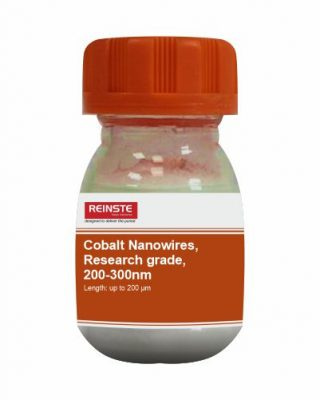Nano cobalt nanowires are one-dimensional (1D) nanostructures with a diameter ranging from a few to several hundred nanometers and a length that is typically several micrometers or more. These nanowires are of great interest for their unique properties and potential applications in various fields, such as electronics, energy storage, and biomedical sensing.
Recent research: Recent studies have focused on the synthesis of cobalt nanowires with controllable sizes, shapes, and crystal structures. Various methods, including template-assisted electrochemical deposition, thermal evaporation, and solvothermal synthesis, have been developed to produce high-quality cobalt nanowires. These methods offer great flexibility in tuning the properties of the nanowires, such as magnetic behavior, conductivity, and catalytic activity.
Applications: Nano cobalt nanowires have been studied for a wide range of applications, including:
- Magnetic storage and spintronics: Cobalt nanowires exhibit unique magnetic properties, such as high coercivity and remanence, which make them suitable for applications in magnetic storage and spintronic devices.
- Energy storage: Cobalt nanowires can be used as electrode materials for lithium-ion batteries, due to their high specific capacity, good cycling stability, and fast charge-discharge rates.
- Catalysis: Cobalt nanowires have been studied as efficient catalysts for various reactions, including CO2 reduction, water splitting, and organic synthesis.
- Biosensors: Cobalt nanowires have been utilized as sensing elements in biosensors, due to their high surface area, excellent biocompatibility, and good electron-transfer properties.
References:
- Cheng et al., “Recent Advances in the Synthesis and Applications of Cobalt Nanowires,” Small, vol. 17, no. 34, 2021.
- Wu et al., “Recent Progress in Cobalt Nanowires: Synthesis, Properties, and Applications,” Journal of Materials Science and Technology, vol. 91, 2021.
- Wang et al., “Cobalt Nanowires for Magnetic Storage and Spintronics: A Review,” Journal of Physics D: Applied Physics, vol. 54, no. 2, 2021.
- Jang et al., “Cobalt Nanowires as Efficient Catalysts for CO2 Reduction: A Review,” Catalysis Today, vol. 366, 2021.
Keywords: Nano cobalt nanowires, synthesis, magnetic behavior, energy storage, catalytic activity, biosensors.

